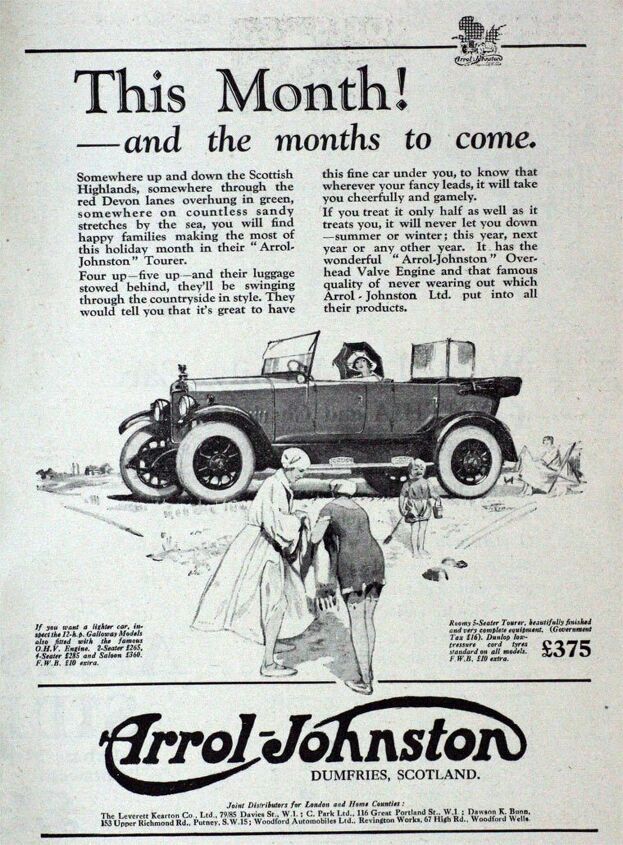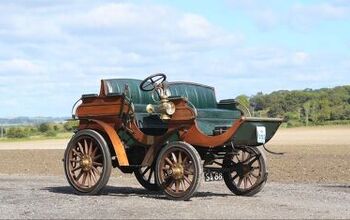Rare Rides Icons: Arrol-Johnston, First Four-wheel Brakes and Inventor of Off-road Vehicles (Part II)

In our introductory article on historical Scottish car maker Arrol-Johnston, we covered the company’s 1895 inception, its invention of four-wheel automotive brakes, and the financial difficulties that led it to become a subsidiary company under steel magnate William Beardmore. Today we finish with the brand’s rise to luxury and rather rapid demise.
After a corporate restructuring at the hands of William Beardmore that saw company founder George Johnston head off for greener pastures, Beardmore set his sights on the development of Mo-Car Syndicate, the separate assembly company behind Arrol-Johnston’s vehicles. One of the first changes came in 1905 when the syndicate company was absorbed into a new combined entity: Arrol-Johnston Car Company Ltd.
The Dogcart was still on sale and still built at the factory in Paisley, Scotland on the western edge of Glasgow. Beardmore’s extensive experience and investment in iron and steel components allowed Arrol-Johnston to make almost all its parts in-house. This was helpful at a time when the assembly line and mass production hadn’t been invented yet.
The same year Arrol-Johnston changed its corporate name, it also reworked the Dogcart. With an updated body appearance, the new version used a large two-cylinder engine of 3.0-liters displacement. This new version was called the 12/15, as it made 12 horsepower at 800 RPM, and 15 horsepower at 1,100 RPM. Another development was a three-cylinder version, which managed 16 horsepower. But there was a cost in the way of lessened refinement. The three-cylinder was still an opposed-piston design but had an unbalanced design: A larger central cylinder was flanked by two smaller ones.
While the 12/15 and three-pot were in production, Arrol-Johnston announced its first four-cylinder car, the 24/30. That engine was an inline or “vertical” four in the nomenclature of the day and offered between 24 and 30 horsepower from its 4.7 liters, dependent upon RPM. Shortly thereafter, the inline-four grew to a massive 8.8 liters displacement, in the range-topping 38/45 model. The 38/45 was available from 1907.
A landmark moment happened in 1907 when the company was contracted to engineer a polar exploration vehicle for the British South Polar Expedition. Arrol-Johnston worked up a version of the 12/15 that was specially built to deal with the conditions in Antarctica. Perhaps unknowingly, they created the first purpose-built, off-road automobile. Air-cooled, the engine ran on alcohol so it wouldn’t freeze in sub-zero temperatures. The car was sent to Antarctica in 1908 with Ernest Shackleton’s expedition, Nimrod. The first car ever on the Antarctic continent, the 12/15 broke down a lot, overheated even in the freezing conditions, and got stuck even in light snow. Some cool pictures from the expedition are here. Though very noteworthy as the first-ever off-road vehicle, the 12/15 was so ineffective that it didn’t do much except drive around the base camp.
The 12/15 was one of Arrol-Johnston’s more popular models and continued in production alongside the four-cylinder models through 1909. 1910 saw the arrival of the 15.9 hp, a new car that revised the brand’s nomenclature, and quickly became its volume model.
In 1909 A-J brought a new engineer into the fold: T.C. Pullinger. Pullinger was hand-picked by William Beardmore to lead the company’s development, both engineering and otherwise. Pullinger worked on bicycles until cars came into existence, at which point he found cars much more interesting. He worked at Sunbeam and Humber before moving to Arrol-Johnston. Pullinger was responsible for the expansion of the company’s engineering and manufacturing. A progressive, Pullinger created structured apprenticeship programs for young engineers to join Arrol-Johnston and even opened an engineering college for women. More on that shortly.
Pullinger visited the United States in an effort to learn about mass production and modern car factory design. His learnings were put to use in a brand new factory in Dumfries, close to the border with England. Arrol-Johnston hired a cutting-edge architect for their new facility, a man by the name of Albert Khan. Constructed in 1913, the new facility was made of steel-reinforced concrete and had big windows, and is believed to be the first such structure in Great Britain. Khan had very recently designed Ford’s Highland Park Model T factory when he was hired by A-J.
The new factory didn’t build many cars before the start of World War I, but the ones it did build were interesting. In an agreement with American firm Anderson Electric that produced the Detroit Electric car, Arrol-Johnston contracted to build 50 electric cars. (Today the total number of EVs produced is unclear.) Other Arrol-Johnstons produced at the factory were several more advanced versions of the company’s offerings, which included boat-tail luxury roadsters and pickup trucks. At least one model had an inline-six engine. A-J called that one the 23.9 hp.
Pullinger was also in charge of the company’s expansion into a second factory in 1916 – another new assembly plant at Kircudbright. As World War I mandated wartime production, the new factory built airplane engine parts. The engineering college for women was a part of this factory, in conjunction with a structured apprenticeship program. When WWI concluded, the assembly at Kircudbright built Galloway models, a line of Arrol-Johnston models for the “economic” end of the market.
The company’s first car after WWI was the suitably named Victory of 1919. It was the brand’s first model to employ overhead cams, in an inline-four engine that produced 40 horsepower. The very first example was delivered to the Prince of Wales, where it proved utterly unreliable. The Royals were most displeased when it broke down during a tour of the West of England, and much negative attention was brought to Arrol-Johnston. Desperate for a quick fix, A-J dropped the Victory and returned to selling a modernized version of the 15.9 hp model sold before the War. Engineers successfully developed that car into the 20 hp, sold alongside the 15.9 from 1922 onward.
The aforementioned Galloway models debuted in 1921 and were intended to be a more affordable alternative to the more luxurious Arrol-Johnston cars and a separate brand. A-J didn’t use their own car for the first Galloway but rather reworked a Fiat 501. The debut model was the 10/20, which used a flathead four of 1.5 liters displacement. That engine grew in 1925 into the 12/20 (1.7L) and 12/30. A Galloway called the Empire was made for the United States market, and it used a 3.3-liter inline-four. Worth noting: Though the Galloway models were “affordable” they still depicted owners with their own driver in ads.
Arrol-Johnston continued as a moderately successful luxury firm after the war, and merged with a newcomer British company, Aster, in 1927. Aster existed only since 1922 and was a luxury manufacturer with roots in the late 1800s as a licensed builder of Aster engines from France. The newly merged pair were known as Arrol-Aster, in a move that sealed the fate of both companies.
The first order of business was product consolidation, as both firms operated in the luxury market. For their part, A-J kept only the 15.9 hp in production, while Aster kept both of their luxury cars. Asters on offer were the very luxurious 21/60 and 24/70. For reference, the 24/70 asked £1,200 in 1927, or £75,000 adjusted ($101,900 USD). Both Arrol and Aster were very luxurious marques at the time and had no use for the affordable brand Galloway, so it was shuttered in 1928. Jointly, the company marketed a new model known as the 17/50.
The old 15.9 and 21/60 cars were quickly discontinued, as a new 3.3-liter straight-eight model arrived for 1929. It used the inline-six of the Aster 17/50 but was much more expensive as it had two additional cylinders. With the straight-eight, Arrol-Aster headed even further upmarket and discontinued the legacy “entry-level” models of both brands, just as The Great Depression began. A notable and unpopular option on the new inline-eight was a supercharger. The supercharged car wasn’t as nice to drive as the naturally aspirated model, as it lacked the sleeve valves utilized by the standard engine. That meant the supercharged variant was less refined and had a lower rev limit. It was also marketed as a sports car by two companies known for luxury.
But Arrol-Aster didn’t have enough time to head in a different direction with its models. Like we heard with Isotta Fraschini, the late Twenties were not kind to high-end luxury manufacturers. The new Arrol-Aster company lasted only two years and went into bankruptcy in 1929. A few straggler cars were sold as the company limped along for the next two years, and closed up shop in 1931.
[Images: Arrol-Johnston]

Interested in lots of cars and their various historical contexts. Started writing articles for TTAC in late 2016, when my first posts were QOTDs. From there I started a few new series like Rare Rides, Buy/Drive/Burn, Abandoned History, and most recently Rare Rides Icons. Operating from a home base in Cincinnati, Ohio, a relative auto journalist dead zone. Many of my articles are prompted by something I'll see on social media that sparks my interest and causes me to research. Finding articles and information from the early days of the internet and beyond that covers the little details lost to time: trim packages, color and wheel choices, interior fabrics. Beyond those, I'm fascinated by automotive industry experiments, both failures and successes. Lately I've taken an interest in AI, and generating "what if" type images for car models long dead. Reincarnating a modern Toyota Paseo, Lincoln Mark IX, or Isuzu Trooper through a text prompt is fun. Fun to post them on Twitter too, and watch people overreact. To that end, the social media I use most is Twitter, @CoreyLewis86. I also contribute pieces for Forbes Wheels and Forbes Home.
More by Corey Lewis
Latest Car Reviews
Read moreLatest Product Reviews
Read moreRecent Comments
- Michael S6 Very confusing if the move is permanent or temporary.
- Jrhurren Worked in Detroit 18 years, live 20 minutes away. Ren Cen is a gem, but a very terrible design inside. I’m surprised GM stuck it out as long as they did there.
- Carson D I thought that this was going to be a comparison of BFGoodrich's different truck tires.
- Tassos Jong-iL North Korea is saving pokemon cards and amibos to buy GM in 10 years, we hope.
- Formula m Same as Ford, withholding billions in development because they want to rearrange the furniture.












































Comments
Join the conversation
KAHN! Required post.
Thank you for the very informative article. I own a 1927 Arrol-Johnston Dominion Tourer so was very interested in the facts, history and pictures in the article. Keep up the great work! PS. A lot of interesting cars and motorcycles came out of Scotland! Cheers, Colin Stevens, South Australia.